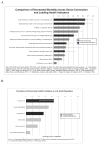Advancing social connection as a public health priority in the United States
- PMID: 28880099
- PMCID: PMC5598785
- DOI: 10.1037/amp0000103
Advancing social connection as a public health priority in the United States
Abstract
A robust body of scientific evidence has indicated that being embedded in high-quality close relationships and feeling socially connected to the people in one's life is associated with decreased risk for all-cause mortality as well as a range of disease morbidities. Despite mounting evidence that the magnitude of these associations is comparable to that of many leading health determinants (that receive significant public health resources), government agencies, health care providers and associations, and public or private health care funders have been slow to recognize human social relationships as either a health determinant or health risk marker in a manner that is comparable to that of other public health priorities. This article evaluates current evidence (on social relationships and health) according to criteria commonly used in determining public health priorities. The article discusses challenges for reducing risk in this area and outlines an agenda for integrating social relationships into current public health priorities. (PsycINFO Database Record
(c) 2017 APA, all rights reserved).
Figures


References
-
- Anderson LM, Shinn C, Fullilove MT, Scrimshaw SC, Fielding JE, Normand J … Task Force on Community Preventive Services. The effectiveness of early childhood development programs - A systematic review. American Journal of Preventive Medicine. 2003;24(3):32–46. doi: 10.1016/s0749-3797(02)00655-4. - DOI - PubMed
-
- Authors/Task Force Members. Piepoli MF, Hoes AW, Agewall S, Albus C, Brotons C, … Verschuren WMM. 2016 European Guidelines on cardiovascular disease prevention in clinical practice: The Sixth Joint Task Force of the European Society of Cardiology and Other Societies on Cardiovascular Disease Prevention in Clinical Practice (constituted by representatives of 10 societies and by invited experts). Developed with the special contribution of the European Association for Cardiovascular Prevention & Rehabilitation (EACPR) European Journal of Preventive Cardiology. 2016;23:NP1–NP96. doi: 10.1177/2047487316653709. - DOI - PubMed
MeSH terms
Grants and funding
LinkOut - more resources
Full Text Sources
Other Literature Sources
Medical
